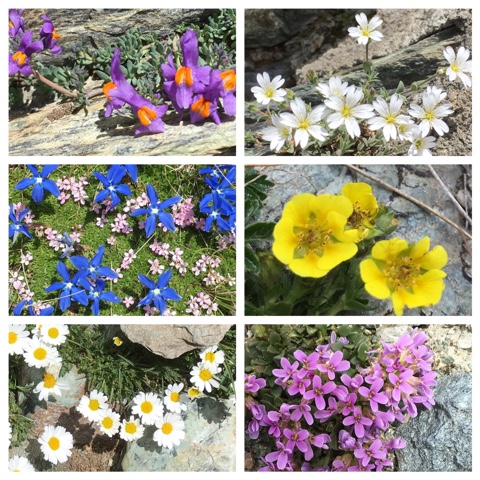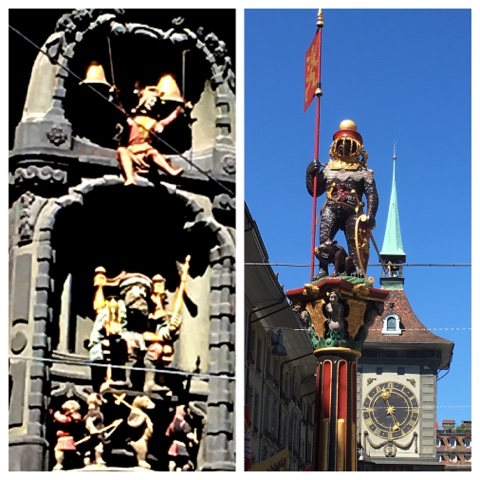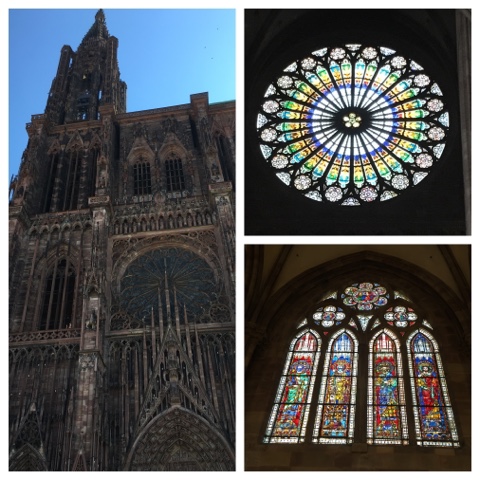Karen had never been and Steve was there on a McKinsey assignment for about 5 months, well a really long time ago. So while we were in the neighborhood, why not take the 50 minute train ride from Lucerne to Zurich?
As we walk from the Park Hyatt near Lake Zurich, to the old town, we wait for the iron man (or person, if we were being politically correct) to pass. Public athletics seems to be a theme in so many places we have visited making us feel just a tiny bit guilty about the daily afternoon gelato. This lovely enamel piece, on the right above, reminds us of the iconic alphorn. Note the blue and white flag, which is on a diagonal, which is specific to Zurich's canton. (What is Massachusets state flag, again?)
The old town along the Limmat River, has charming cobbled walking streets for both tourists and residents alike. The merchant guild houses, dating back to as early as 1303, often have restaurants or places to stop for a cocktail down below, providing a chance to look out over the 22 mile Limmat River which joins Lake Zurrich or Zurichsee.
Besides sidewalk cafes, there are numerous shops, walls painted with frescos of days gone by and the occasional embellished dairy cow. Naturally watches can be found in abundance. We couldn't resist these vintage Mickys. What's interesting is how few digital options you see, clearly showing a preference for the country's long time watch heritage.
What trip to Zurich would be complete without fondue? The charming, whitewashed, Le Dezaley has been opened since 1903. Their mix of Gruyere and Vacherin Fribourgeois, which has a full, distinctive flavor and does not make the sauce stringy, with a dash of Fendant or Sauvignon Blanc is just as Steve remembered, and you will too!
The distinctive Fraumunster is one of the oldest religious buildings in Zurich, founded on July 21, 853 as a Benedictine convent, with sisters Hildegard and then Bertha as its first two abbesses. The Abby's great importance is reflected by the 11th century royal decree, granting it the right to mint coins, hold markets and collect tolls. From the 13th century, the incumbent abyss was also the formal ruler of the city of Zurich and given the title of imperial princess. The era ended with the Reformation of 1524, the last abbess handing over the keys and all its assets to the city of Zurich. At this time the altars were removed and the central pulpit added transforming the Frauminster into a Reformed Protestant church, which it still is today. There is an impressive 29 foot tall stained created in 1903 by the Swiss artist, Augusto Giacometti. However, it is the Jewish artist Marc Chagall's rose window and five stained glass windows depicting scenes from the Old Testament, along with the birth and death of the Redeemer that helps to attract over 500,000 visitors each year. The windows were inaugurated in 1970 in the presence of the then 83-year-old Chagall, of which Picasso said, "Somewhere on the other side of his head there must be an angel."
The Kunsthaus Zurich contains one of Zurich's most important art collections. The museum's collection spans centuries. My particular favorite is the Giacometti collection. Although it focuses on Augusto, there are also works of his father, the post impressionist painter Giovanni, and his younger brother Diego. The contemporary collection is housed in an impressive airy space and a new building has begun across the street. Outside Rodin's Gates of Hell are installed. Overall an impressive and comprehensive art museum that's well worth a trip and is an easy walk from the more tourist filled areas. And, if you're feeling adventurous and looking for panoramic views, you can take the nearby cog train up into the hills.
The nearby stately Dolder Grand, built in 1905, is beautiful and certainly worth a visit, if not to stay for its spa and surroundings, at least for a cocktail and the view. Its sister hotel and restaurant slightly down the mountain, Walhuas Dolder, can be reached from town by cog train but is about to be closed for a major renovation.
Zurich is considered one of the world's most livable cities. It may be Switzerland's largest, but with a population of less than 500,000, you'll never feel closed in. So whether you prefer the old historical areas or the contemporary, the Limmat River or Lake Zurich, you will be simply delighted with a visit here.



















































